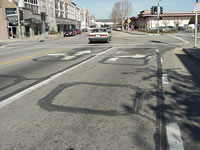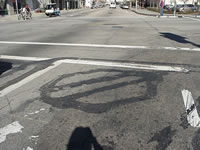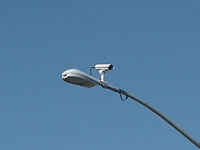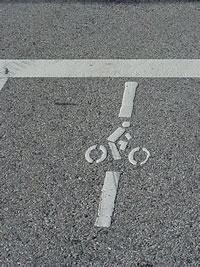Bicycle Detection at Traffic Signals
Santa Cruz, California
Cheryl Schmitt, Bicycle/Pedestrian Coordinator, Santa Cruz, CA
Background
Bicyclists' inability to "get a green light" at signalized intersections was the cause of many phone calls to the Traffic Engineering office of Santa Cruz, California. Callers typically expressed frustration, confusion, and a sense of modal discrimination. The Bicycle Detection Program was developed as a two-phase strategy to address these complaints. Phase 1 involved correcting actual detection problems at each traffic signal. Phase 2 involved educating the public about how and where to be detected at traffic signals.


Loop detection for bicyclists and motorists.
Countermeasure
At the time, the City of Santa Cruz had 40 signalized intersections. Thirty intersections used inductive loop detection and 10 intersections used video detection. A typical loop layout was three "A" loops and a stop bar "Q" or "D" loop for each motor vehicle lane. Bicycle lanes typically had a bike "Q" loop at the stop bar for the minor legs, and bicycle detection was not always provided for the major legs if the signal rested in green on the major legs. Video detection intersections used Peek Video cameras. Four arterial corridors were interconnected using Traconet with Traconex controllers.
Phase 1: Engineering
- Citizen requests and work orders regarding bicycle detection were compiled to determine signals with a history of complaints.
- A work list was created prioritizing locations and the stated complaints, with proposed short-term and/or long-term solution and cost estimate for each location.
- The Bicycle/Pedestrian Coordinator and the Traffic Signal Technician performed field tests at each intersection location. The coordinator rode an aluminum frame bicycle over each lane and the Technician recorded the level of detection at the signal cabinet. Detection levels were adjusted and re-tested as necessary to detect the bicycle (short-term solution).
- Long-term solutions included: cutting new loops, adjusting cameras, and installing bike push buttons where necessary. These repairs were funded from an annual Minor Traffic Signal Maintenance budget.

Camera used in video detection.
Phase 2: Education
- The lead loop in left-turn lanes, curbside lanes without bike lanes, and bike lanes were marked with the Manual of Uniform Traffic Control Devices bike detector marking if sawcut lines were not visible.
- A brochure was developed to describe how traffic signals work and to explain where bicyclists should position themselves on sawcut lines to be detected. This brochure is available on the city's website.
- Signal detection was discussed at the two-hour bicycle safety class required of all applicants to the regional bike loan and e-bike rebate programs. Over 500 participants received the Bicycle Detection brochure through this program.
- Bicyclists on the local email bike list were kept abreast of the program and encouraged to contact the Bike/Pedestrian Coordinator with comments.
Evaluation and Results

A symbol may be placed on the pavement indicating the optimum position for a bicyclist to actuate the signal.
While behavioral observations were not collected and analyzed to evaluate this project, it is likely that improved detection for bicyclists deterred red light running and other unsafe behaviors by reducing delay at signalized intersections.
Overall, complaint calls to the Traffic Engineering office decreased dramatically. Bicyclists on the local email bike list and bicyclists newsletter reported a greater level of confidence that they would be detected and therefore a greater willingness to wait through the red.
Conclusions and Recommendations
Some of the technical problems were difficult to solve. Turning up the sensitivity on the detector amplifier to detect bikes will sometimes work for a period of time, but it usually ends up "locking on," causing a maximum recall condition. Rapidly decaying street infrastructure also results in more loop failures, so these repairs often need to wait until the entire roadway infrastructure is improved.
Video detection is much more reliable overall, but there was a learning curve for the field crew to become proficient with it. Nevertheless, the Bicycle Detection Program has been, and continues to be, a success.
Costs
Loops were approximately $500 each; for bike detection, there are typically two loops per direction of travel. Video detection is approximately $35,000 for a complete intersection installation. Pedestrian/bicyclist push buttons with the conduit and conductor to the controller cabinet were approximately $1,500; and each pole with push button was about $300.
Contact
Cheryl Schmitt
Bicycle/Pedestrian Coordinator
City of Santa Cruz Public Works Department
809 Center Street, Room 201
Santa Cruz, CA 95060
(831) 420-5187

